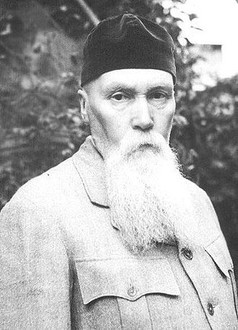Master Building, New York City
Introduction
Text-to-speech Audio
The Master Building is a twenty-seven story Art Deco structure built between 1928 and 1929 and home to the Master Institute of United Arts, the Roerich Museum, and hundreds of apartments. Nicholas and Helena Roerich led the effort to create the art institute and museum with the financial backing of Louis L. Horch. The building was designed by Harvey Wiley Corbett and is regarded as one of the best examples of the architect's work. While the financial downturn of the 1930s led to the building being placed in receivership and the Roerich Museum moved out of the building, it remains historically significant because for its effort to build a mixed-use structure that combined the study of art with everyday life. The Master Building is listed on the National Register of Historic Places.
Images
The Master Building

Nicholas Roerich

Backstory and Context
Text-to-speech Audio
Russian-born artist Nicholas Roerich came to the United States in 1920 at the invitation of the Chicago Institute of Art. The following year, he founded the Master Institute of United Arts in New York. Roerich remained in the United States for several years, during which time he was busy with both his art and his activism.
Roerich attracted the attention of financier Louis Horch. Both Horch and his wife, Nettie, had an interest in the arts and were charmed by Roerich's charisma and their shared interest in Asian arts. Horch would eventually pay off Roerich's debt and invest large sums in the Master Institute of United Arts. Roerich also met Sina and Maurice Lichtmann, who were Russian pianists who developed an interest in Roerich's work and worked with him to establish a school.
In 1923, Lichtmann purchased property on Riverside Drive which would eventually be the site of the Master Institute, which was originally located in an apartment above a Greek Orthodox Church. Eventually, Lichtmann's property and some neighboring lots were deeded to the Master Institute and the Roerich Museum, which was to be housed in the building as well.
From the beginning, the new building was intended to connect art with everyday life. The twenty-nine story building was to house apartment units, as well as the Roerich Museum, the Corona Mundi art museum, and spaces for classes, exhibitions, art galleries, theaters, and conference halls. Apartments were included in the plans for the building in the hope that rental property would make the school and related facilities self-sufficient.
The building was completed in 1928, just before the Great Depression and was one of the last of the major construction projects along Riverside for a number of years. Within a few years, Horch and Roerich had a dispute, and as a result, Horch placed Roerich's paintings in storage and renamed the museum the Riverside Museum, which focused on contemporary art. The museum was in operation for decades, until eventually its space was sold and its collections transferred to Brandeis. The building was converted into a cooperative in the 1980s.
The Master Building is a New York City Landmark and is also listed on the National Register of Historic Places.
Roerich attracted the attention of financier Louis Horch. Both Horch and his wife, Nettie, had an interest in the arts and were charmed by Roerich's charisma and their shared interest in Asian arts. Horch would eventually pay off Roerich's debt and invest large sums in the Master Institute of United Arts. Roerich also met Sina and Maurice Lichtmann, who were Russian pianists who developed an interest in Roerich's work and worked with him to establish a school.
In 1923, Lichtmann purchased property on Riverside Drive which would eventually be the site of the Master Institute, which was originally located in an apartment above a Greek Orthodox Church. Eventually, Lichtmann's property and some neighboring lots were deeded to the Master Institute and the Roerich Museum, which was to be housed in the building as well.
From the beginning, the new building was intended to connect art with everyday life. The twenty-nine story building was to house apartment units, as well as the Roerich Museum, the Corona Mundi art museum, and spaces for classes, exhibitions, art galleries, theaters, and conference halls. Apartments were included in the plans for the building in the hope that rental property would make the school and related facilities self-sufficient.
The building was completed in 1928, just before the Great Depression and was one of the last of the major construction projects along Riverside for a number of years. Within a few years, Horch and Roerich had a dispute, and as a result, Horch placed Roerich's paintings in storage and renamed the museum the Riverside Museum, which focused on contemporary art. The museum was in operation for decades, until eventually its space was sold and its collections transferred to Brandeis. The building was converted into a cooperative in the 1980s.
The Master Building is a New York City Landmark and is also listed on the National Register of Historic Places.
Cite This Entry
Woodham, Rebecca and Clio Admin. "Master Building, New York City ." Clio: Your Guide to History. May 28, 2019. Accessed August 14, 2025. https://theclio.com/entry/81092
Sources
Gray, Christopher. Streetscapes/The Master Apartments; A Restoration for the Home of Russian Philosopher. New York Times. January 29, 1995. Accessed May 27, 2019. https://www.nytimes.com/1995/01/29/realestate/streetscapes-master-apartments-restoration-for-home-russian-philosopher.html.
Master Apartments. . Accessed May 27, 2019. https://masterapts.com/building-history/.
Master Building. nps.gov. . Accessed May 27, 2019. https://www.nps.gov/nr/feature/places/pdfs/16000036.pdf.
Master Apartments. . Accessed May 27, 2019. https://masterapts.com/building-history/.
Master Building. nps.gov. . Accessed May 27, 2019. https://www.nps.gov/nr/feature/places/pdfs/16000036.pdf.

